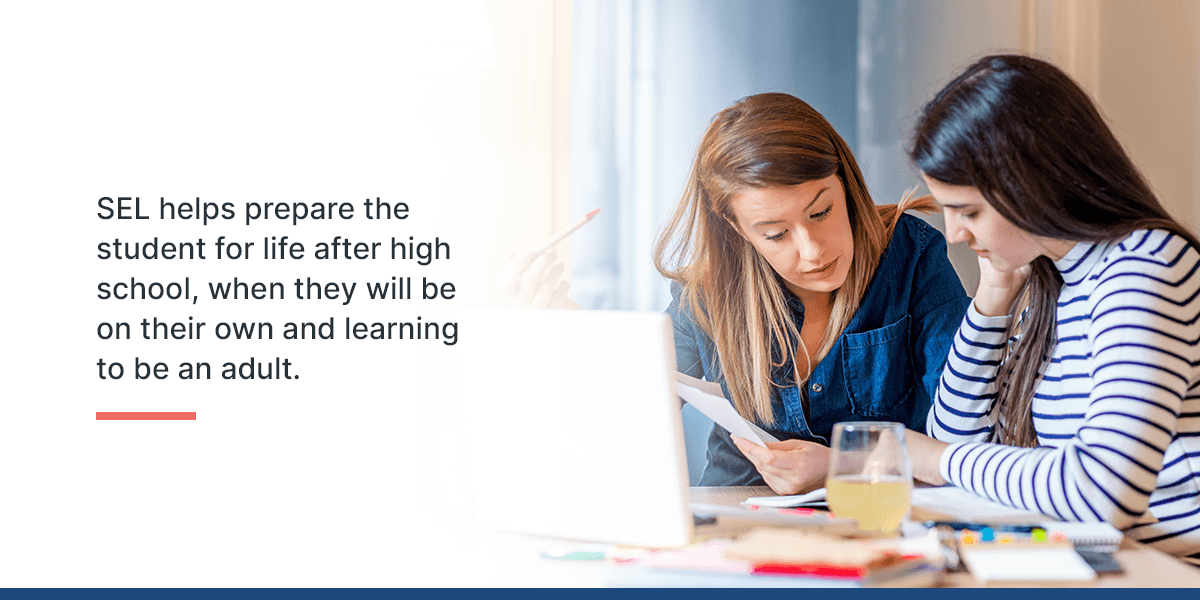How to Teach SEL to High Schoolers

High school is one of the most crucial moments in a teenager's life. Not only do they have to navigate classes, grades and future prospects, but they also undergo psychological, physical and emotional changes at the same time. If left unprepared and alone, high schoolers can quickly succumb to the stress and hardships, making their experience all the more challenging. During this period, high school students have to establish an identity, find ways to integrate into social communities and process their shifting emotions. To better help high schoolers cope and manage their emotions, social-emotional learning (SEL) gives them the structure and support they need.

What Is SEL?
SEL functions as a means for students, teachers and other individuals to better understand their emotions, positively express these feelings and demonstrate empathy for people around them. By utilizing these skills, learners can set and achieve positive goals, establish and strengthen constructive relationships, make healthy choices and safely manage their emotions. Culturally Responsive Social-Emotional Learning (CRSELF) is another component of this concept that adapts to cultural differences.
The overarching goal of SEL is for students to demonstrate a mastery of the five core competencies:
• Self-awareness
• Self-management
• Social awareness
• Relationship skills
• Responsible decision-making

High school comes at a time when cognitive growth and hormones play a vital role in the future development of identity and purpose. SEL helps prepare the student for life after high school, when they will be on their own and learning to be an adult. SEL gives them the tools and strategies they need to better process the world around them and function effectively in society.SEL also works as a means for high schoolers to feel competent, respected and valued in their communities. This sense of purpose can help make learners feel more motivated and engaged with their peers.
How to Teach SEL to High Schoolers
While the importance of SEL is easy enough to comprehend, implementing this style of teaching may take some practice. As an educator, you are guiding emotionally driven and emotionally immature students into expressing themselves openly. To help you start, we've compiled a list of eight activities for your students to try:
- Discussion of Emotions
Understanding our feelings is pivotal to our emotional well-being. High schoolers have a difficult time expressing their emotions safely without letting them escalate. You want to give your learners a safe environment to express how they feel. You can achieve this expression in a multitude of ways. Let your students discuss their current emotions in a group setting, or try speaking to them individually. Having your students write down their emotions is also a great way for them to privately express themselves. - Motivation Identification
Everyone has motivations that drive them to complete goals and tasks. These motivations can be as big as finishing a novel or as small as brushing your teeth. You want your students to recognize these motivations and explain why these things encourage them. This exercise can help teenagers better understand themselves. - Quote or Word of the Week
Utilizing a quote or word is an effective way to fully discuss various emotions and concepts. Quotes allow your students to interpret meanings and apply them to their lives. For words, you can introduce terms that help your students identify an emotion. If you choose this method, refrain from using common words like "happy" or "angry." Instead, use more complex ones like "indignant" or "melancholy." - Perspective Switching
While your students focus on understanding themselves, you don't want them to become so consumed in their individuality that they fail to recognize the plights of others. Switching perspectives helps strengthen your students' empathy. Taking a movie, book or another form of media, you can create a series of questions about the story's protagonists and antagonists. Ask questions that encourage students to see the situation from both perspectives. - Circle Sharing With Groups
Circle sharing is also another great activity to strengthen teenagers' empathy skills. Rather than interpreting the feelings of fictional characters, circle sharing encourages students to partake in active listening and better understand their classmates' feelings. Ask them questions that promote understanding of these feelings. However, you will need to establish a set of ground rules before you begin such an exercise. You are dealing with the emotions of fragile teenagers, and you want to create a haven for them to express these feelings without judgment. - Interactive Content
Some students have a difficult time expressing and understanding content through group exercises. Interactive content provides your learners with an alternative means of processing and understanding their emotions and recognizing empathy for others without the influences of peer pressure. Interactive content can utilize culturally responsive messaging, which allows students to put themselves into real-life situations and apply these scenarios to their lives. - Climate Mapping in School
Climate mapping helps students identify their needs, create a list of achievable goals for themselves and track their progress in accomplishing these goals. First, your students should identify the things they need to better themselves. Then, they should create a set of goals based on these needs. Finally, as each individual achieves one of their set goals, they can check it off their list. - Meaningful Online Messages
All students engage in online activities of some form, whether through gaming, social media or text messaging. It's crucial for teenagers to understand the dangers of misinterpreting online messaging. To demonstrate this danger, you could do an exercise where you write a sentence and read it in several different tones. Explain to your students how the tone is missing from online messages, which can make it more difficult to interpret another person's meaning. This activity helps students more effectively resist misinterpreting information.
Improve Your SEL Curriculum With Lessonbee
Without a doubt, SEL is a useful teaching method to help your high school students take ownership of and control their emotions safely and positively. More importantly, SEL works effectively alongside other courses. By using these eight SEL learning activities, you can find ways to incorporate SEL into all areas of high school. SEL teaching doesn't have to be stressful. If you're feeling intimidated by the idea of introducing SEL activities for high schoolers, trust Lessonbee to provide you with the tools you need. We offer fully interactive lessons and materials to help you strengthen your students' emotional stability. Create an account today, and see how Lessonbee can help improve your SEL curriculum for your high schoolers.
Subscribe to get notified on Lessonbee updates and new blog posts







